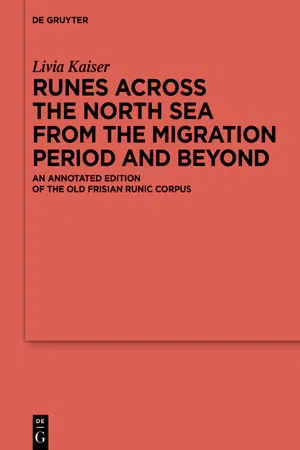
Runes Across the North Sea from the Migration Period and Beyond
An Annotated Edition of the Old Frisian Runic Corpus
- 482 pages
- English
- ePUB (mobile friendly)
- Available on iOS & Android
Runes Across the North Sea from the Migration Period and Beyond
An Annotated Edition of the Old Frisian Runic Corpus
About This Book
The scattered research history of the Old Frisian runic inscriptions dating to the early Medieval period (ca. AD 400–1000) calls for a comprehensive and systematic reprocessing of these objects within their socio-cultural context and against the backdrop of the Old English Runic tradition. This book presents an annotated edition of 24 inscriptions found in the modern-day Netherlands, England and Germany. It provides the reader with an introduction to runological methodology, a linguistic commentary on the features attested in the inscriptions, and a detailed catalogue which outlines the find history of each object and summarizes previous and new interpretations supplemented by pictures and drawings. This book additionally explores the question of Frisian identity and an independent Frisian runic writing tradition and its relation to the contemporary Anglo-Saxon runic culture. In its entirety, this work provides a rich basis for future research in the field of runic writing around the North Sea and may therefore be of interest to scholars of historical linguistics and early Medieval history and archaeology.
Frequently asked questions
Information
Part 1: Preliminaries
I The Old Frisian Runic Corpus Edition
I.1 Runology and Runological Practice: From Autopsy to Interpretation
For every inscription there shall be as many interpretations as there are runologists studying it.A ‘witty Viking archaeologist’, Page (1999, p. 10)
I.1.1 What is Runology?
Die Runologie stellt ein sehr komplexes Gebiet innerhalb der Fächer ‘Germanische/Nordgermanische/Englische Philologie’ dar. Sie ist von vorne herein auf interdisziplinäre Zusammenarbeit angelegt. Als wichtige einschlägige Disziplinen seien hier nur die Vor- und Frühgeschichte, die Kunst-, Kultur- und Religionsgeschichte, die Epigraphik, die Numismatik und die Rechtsgeschichte sowie die Germanische Altertumskunde als fächerübergreifende Spezialdisziplin genannt. 4
An independent runological discipline, if it is to be established, must therefore deal with the runic symbols themselves, individually and as a system, with their developments and their use to record language. Runic inscriptions are sequences of runes placed on an object, and these the runologist will attempt first to read and then to interpret. Reading will involve examination of the inscription itself, since photographs are subject to tricks of the light and drawings will always contain an element of subjectivity. Interpretation will often require help from and some knowledge of other disciplines, notably archaeology. But archaeology is not runology, any more than are art history, mythology, or occultism.
[…] the origin of the runic alphabet, the change from the Older fuþark to the Anglo-Saxon fuþorc and the Younger Scandinavian fuþark, the development of the additional runic characters of the Scandinavian Middle Ages and their status, runes as graphemic systems, the distinction between graphs, graph types, graphemes and units of the fuþark, and the principles and practice of transliteration.
[…] a difficult but rewarding activity in which precision and experience on a solid philological and linguistic basis works in cooperation with the relevant related sciences requiring imagination and deductive powers but also rational, critical control, in order to offer a plausible explanation for the meaning, role, and importance of an inscription and the object that bears the runes.Düwel (2004a, p. 140)
Table of contents
- Title Page
- Copyright
- Contents
- Abbreviations
- Introduction
- Part 1: Preliminaries
- Part 2: Linguistic Analyses
- Part 3: The OFRC Edition
- Appendix I: North-Sea Germanic Phonological and Morphological Feature Catalogue
- A Basic Keywords: Objects, People and Linguistic and Runological Terms
- B OFRC Sources: Inscriptions Listed and Discussed in this Edition
- C.1 Old English and Pre-Old English Runic fuþorc Inscriptions [OERC] (cp. Waxenberger 2010)
- C.2 Southern Germanic fuþark Inscriptions (cp. Krause/Jankuhn [KJ] 1966, Opitz [O] 1981, OBJECT s. v. KIEL Database.
- C.3 Older Germanic fuþark Inscriptions (cp. Arntz/Zeiss [AZ] 1939, Krause/Jankuhn [KJ] 1966, Danmarks Runeindskrifter [DR] (1941–1942), OBJECT s. v. KIEL database).
- C.4 Younger fuþąrk Inscriptions (cp. Arntz/Zeiss [AZ] 1939, Krause/Jankuhn [KJ] 1966, Danmarks Runeindskrifter [DR] (1941–1942), OBJECT s. v. KIEL database).
- C.5 Unascribed Runic Inscriptions (cp. Arntz/Zeiss [AZ] 1939, Krause/Jankuhn [KJ] 1966, Danmarks Runeindskrifter [DR] (1941–1942), OBJECT s. v. KIEL database).